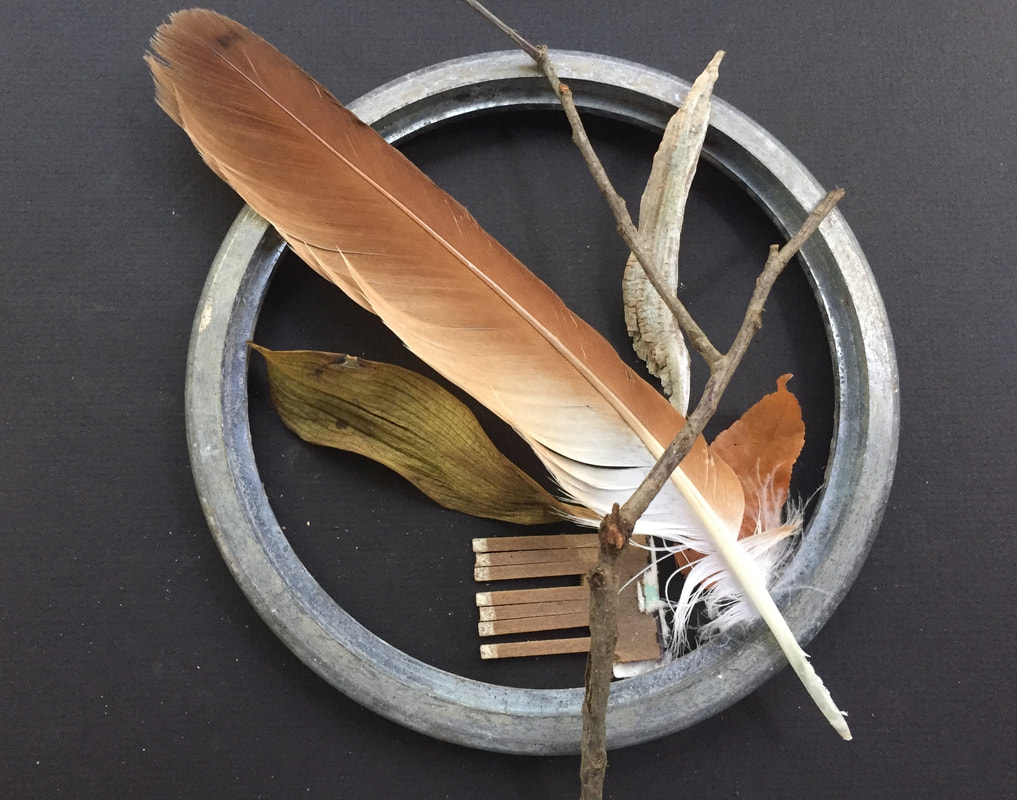Did you look for found objects today? Lots of people have been doing it, and they’re sending me photos of their great compositions. This one is by Marilyn Jones:

Marilyn Jones, found object composition
If you haven’t checked out our online Found Object gallery in a while, see what’s new HERE.
So what’s the next step? Sometimes it’s just enough to photograph them for the record, but you also might want to save them for a more fixed form as assemblage components.
I regularly combine found objects with small earthenware pieces (which were made for no particular purpose) to create assemblages. You can do the same thing with air-dry clay if you don’t have a kiln (see a couple of possibilities at the end of this post).
Here’s an assemblage example that I finished yesterday:

Some of the pieces are found, some made of clay, and some repurposed, like the old paintbrush.
I keep a couple of trays of unfinished clay shards handy so I can try various combinations, just like we’ve been doing with the found objects

Some are more complete than others, but they are all still just possible components.

Here’s a possible work in progress – it’s not even a “work” yet, just a “play.”

If you make these kinds of clay components, be sure to punch holes in strategic areas in case you want to attach them to other objects. I use various sizes of paper straws.
As I said, it’s easy to do this with air-dry clay, especially since these are small textured “shards.” It’s also a good way to test different kinds of air-dry clay and try out interesting textures.
This is one of my favorite air-dry clays. It’s inexpensive, and dries quickly, especially if you put your pieces on a paper plate out in the Texas sun to dry, That’s the only time I’m grateful for 100F heat! This paper clay takes paint and walnut ink very nicely.

And here’s something new that I’m just getting ready to try – Michael Tarricone wrote me about it:
Hi, Lyn –
I was wondering if you have seen the new Quick Cure Clay from Ranger Ink. I’ve been using it from a few weeks now and it’s really fantastic. It only dries when you apply heat with a heat gun. It dries rock hard in just a couple of minutes. It work beautifully in silicone molds, in face you can cure it in the mold.
Michael’s not associated with Ranger, he just liked the way the clay worked. I ordered some and will give you a report once I try it out this weekend:

If there’s a point to today’s rambling, it’s “don’t be afraid to mix the found with the handmade” – that synergy will often enrich both kinds of components, bringing order to the found and natural richness to the handmade.

Mixing found objects with the handmade components
TGIF! Hove a lovely weekend, and stay cool.

Love that last face! So lovely!
I continue to enjoy the “angel face pocket” I purchased from you years ago. You had lovely fibers hanging from holes at the bottom. I put rosemary from our yard in it. The face was molded from a sculpture at San Fernando Cemetery, I think you said. Love it!
Carlos Haun
Hi, Carlos – I’m so glad you have that face! Yes, it came frm a press mold that I made and fired from a sculpture in San Fernando Cemetery – and rosemary is the herb of remembrance. Perfect!
Lyn, Great post! You are so inspiring!
Lyn, I’ve been playing with Quick Cure Clay as well. You can get some unexpected results, but I’ve learned how to give in to serendipity! It takes colour, after curing, beautifully. Before curing, you can add mica or embossing powder, and it doesn’t require any other adhesive. It never dries out, and is pretty soft, and sticky. Leave the package open for a couple of days, and it will be easier to work with.
Anne Marie – Toronto
Lynn thanks for hosting the found objects challenge, it was such fun and the gallery looks great! You always inspire me!